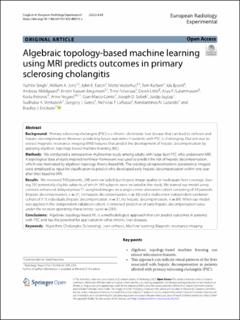| dc.contributor.author | Singh, Yashbir | |
| dc.contributor.author | Jons, William A. | |
| dc.contributor.author | Eaton, John E. | |
| dc.contributor.author | Vesterhus, Mette Nåmdal | |
| dc.contributor.author | Karlsen, Tom Hemming | |
| dc.contributor.author | Bjørk, Ida | |
| dc.contributor.author | Abildgaard, Andreas | |
| dc.contributor.author | Jørgensen, Kristin Kaasen | |
| dc.contributor.author | Folseraas, Trine | |
| dc.contributor.author | Little, Derek | |
| dc.contributor.author | Gulamhusein, Aliya F. | |
| dc.contributor.author | Petrovic, Kosta | |
| dc.contributor.author | Negård, Anne | |
| dc.contributor.author | Conte, Gian Marco | |
| dc.contributor.author | Sobek, Joseph D. | |
| dc.contributor.author | Jagtap, Jaidip | |
| dc.contributor.author | Venkatesh, Sudhakar K. | |
| dc.contributor.author | Gores, Gregory J. | |
| dc.contributor.author | LaRusso, Nicholas F. | |
| dc.contributor.author | Lazaridis, Konstantinos N. | |
| dc.contributor.author | Erickson, Bradley J. | |
| dc.date.accessioned | 2023-01-27T07:48:52Z | |
| dc.date.available | 2023-01-27T07:48:52Z | |
| dc.date.created | 2022-12-05T12:04:22Z | |
| dc.date.issued | 2022 | |
| dc.identifier.issn | 2509-9280 | |
| dc.identifier.uri | https://hdl.handle.net/11250/3046746 | |
| dc.description.abstract | Background: Primary sclerosing cholangitis (PSC) is a chronic cholestatic liver disease that can lead to cirrhosis and hepatic decompensation. However, predicting future outcomes in patients with PSC is challenging. Our aim was to extract magnetic resonance imaging (MRI) features that predict the development of hepatic decompensation by applying algebraic topology-based machine learning (ML).
Methods: We conducted a retrospective multicenter study among adults with large duct PSC who underwent MRI. A topological data analysis-inspired nonlinear framework was used to predict the risk of hepatic decompensation, which was motivated by algebraic topology theory-based ML. The topological representations (persistence images) were employed as input for classification to predict who developed early hepatic decompensation within one year after their baseline MRI.
Results: We reviewed 590 patients; 298 were excluded due to poor image quality or inadequate liver coverage, leaving 292 potentially eligible subjects, of which 169 subjects were included in the study. We trained our model using contrast-enhanced delayed phase T1-weighted images on a single center derivation cohort consisting of 54 patients (hepatic decompensation, n = 21; no hepatic decompensation, n = 33) and a multicenter independent validation cohort of 115 individuals (hepatic decompensation, n = 31; no hepatic decompensation, n = 84). When our model was applied in the independent validation cohort, it remained predictive of early hepatic decompensation (area under the receiver operating characteristic curve = 0.84).
Conclusions: Algebraic topology-based ML is a methodological approach that can predict outcomes in patients with PSC and has the potential for application in other chronic liver diseases. | en_US |
| dc.language.iso | eng | en_US |
| dc.publisher | Springer Open | en_US |
| dc.rights | Navngivelse 4.0 Internasjonal | * |
| dc.rights.uri | http://creativecommons.org/licenses/by/4.0/deed.no | * |
| dc.title | Algebraic topology-based machine learning using MRI predicts outcomes in primary sclerosing cholangitis | en_US |
| dc.type | Journal article | en_US |
| dc.type | Peer reviewed | en_US |
| dc.description.version | publishedVersion | en_US |
| dc.rights.holder | Copyright 2022 the authors | en_US |
| dc.source.articlenumber | 58 | en_US |
| cristin.ispublished | true | |
| cristin.fulltext | original | |
| cristin.qualitycode | 1 | |
| dc.identifier.doi | 10.1186/s41747-022-00312-x | |
| dc.identifier.cristin | 2088657 | |
| dc.source.journal | European Radiology Experimental | en_US |
| dc.identifier.citation | European Radiology Experimental. 2022, 6, 58. | en_US |
| dc.source.volume | 6 | en_US |

